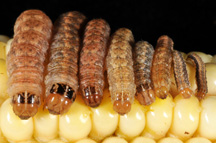Entomologists: Start scouting western bean cutworm in late July
July 18, 2013
 |
|
Early western bean cutworm instars (left) lack the identifying black rectangles that develop with older larvae (right). (Purdue Entomology photo/John Obermeyer) |
WEST LAFAYETTE, Ind. - Corn growers should start scouting in late July for signs of western bean cutworm, a potentially yield-reducing pest, two Purdue Extension entomologists say.
First found in Indiana in 2006, western bean cutworms feed on corn, legumes and dry beans, such as kidney and black beans. Despite the name, they do not feed on soybeans.
The cutworms can be identified by the black rectangles that develop behind the head of the later instars. These are commonly found feeding within the ear in late summer.
Western bean cutworm populations are tracked and roughly estimated each year using pheromone traps placed throughout the state. The traps capture the grayish-white moths, which usually lay eggs on Indiana corn plants in July. Feeding damage can appear a few weeks later.
So far this year, moth captures in northern Indiana are lower than previous years, said John Obermeyer, Purdue Extension entomologist and Indiana trap coordinator. But the number of moth catches does not necessarily give entomologists an accurate number of larvae, and is generally used as a presence or absence tool to initiate scouting.
Larvae begin emergence after a period of warm weather, but extreme conditions, such as last year's drought and excessive heat, are hard on western bean cutworm. With the cooler, wet Indiana spring this year, Purdue Extension entomologist Christian Krupke said the insects are likely delayed.
"We've had a cool spring, so we'd expect emergence a little later than last year," he said. "It is likely that the hot, dry weather that we had last year was not good for them."
In the early stages of development, western bean cutworms feed on pollen caught in leaf axils of corn plants (where the leaf meets the stem). This is when growers should apply insecticides to fields to prevent further damage. Once the cutworm is inside the husk of the corn plant and begins feeding on kernels, insecticides are no longer effective. When pollen is gone, kernel feeding will begin and continue until the first frost.
According to Krupke, western bean cutworms also are sometimes indirect pests because they can increase the risk of ear rot development in corn plants by feeding on corn kernels. Some ear rots produce toxins that can be fatal if consumed by livestock - especially swine.
"When you take your grain to the elevator, they will test for mycotoxins. If it is over the threshold for that particular toxin, they might reject the whole batch," he said. "That's why this insect is a concern, because it makes the fungal pathogen colonize the ear more fully, which in turn raises toxin levels."
Some Bacillus thuringiensis, or Bt, corn hybrids are very effective in resisting western bean cutworm damage, but growers are urged to check the label of their particular hybrids. Scouting and insecticide sprays are effective as well but must take place before larvae enter corn ears.
More information about western bean cutworm scouting can be found at http://extension.entm.purdue.edu/fieldcropsipm/insects/western-bean-cutworm.php
Writer: Hannah Harper, 765-494-8402, harper4@purdue.edu
Sources: Christian Krupke, 765-494-4912, ckrupke@purdue.edu
John Obermeyer, 765-494-4563, obe@purdue.edu
Ag Communications: (765) 494-2722;
Keith Robinson, robins89@purdue.edu
Agriculture News Page

